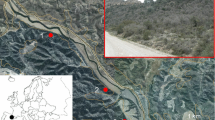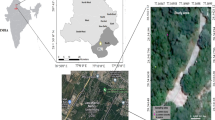Abstract
A phenomorphological survey was carried out in central Italy to study the effects of increasing water stress on some characteristic species of the Mediterranean maquis. Nutrient content and leaf water potential were examined. The results show that three different groups exist which diverge in the modulation of growth activity. 1) Evergreen sclerophyllous species (e.g. Pistacia lentiscus, Phillyrea media, Arbutus unedo, Ruscus aculeatus), which were supposed to be drought-tolerant, in fact limited their growth activity to a brief period before aridity increased. A similar growth pattern was exhibited by those species (e.g. Quercus ilex, Erica arborea, Smilax aspera) that stopped producing new leaves and branches during the driest season and that recovered after the first rain; i.e., their growth period lasted longer. 2) Drought-deciduous species (e.g. Calicotome villosa) that adopted the drought-avoidance strategy had two vegetative periods interrupted by a phase during which they completely shed their leaves. 3) Semideciduous species (Cistus monspeliensis) with mesophitic leaves adopted an intermediate response. These grew even in the dry and cold season.
Similar content being viewed by others
References
Anne 1945. Dosage rapide du carbon organique des sols. Precies de Pédologie PH Duchanfour, Maison & Cie, Ann. Agr. 2: 161–172.
Arianoutsou, M. & Diamantopolous, J. 1985. Comparative phenology of five dominant plant species in maquis and phrygana ecosystems in Greece. Phyton 25 (1): 77–85.
Arianoutsou, M. & Mardiris, Th. A., 1987. Observations on the phenology of two dominant plants of the Greek maquis. In: Plant response to stress. Functional analysis in mediterranean ecosystems. Tenhunen, J. D., Catarino, F. M., Lange, O. L., and Oechel, W. C. (eds): Springer-Verlag: New York-Heidelberg-Tokyo-Berlin: pp. 515–519.
Aschmann, H. 1973. Distribution and peculiarity of Mediterranean ecosystems. Mediterranean Type Ecosystems. Ecological Studies, 7, Springer-Verlag, Berlin-Heidelberg-New York: 11, 20.
Correia, O. A. 1988. Contribucao da fenologia e ecofisiologia em estudos da successao e dinamica da vegetacao mediterranica. Phd Thesis. Facultade de Ciencias da Universidade de Lisboa.
Bazzaz, F. A., Carlson, R. W. & Harper, J. L. 1979. Contribution to the reproductive effort by photosynthesis of flowers and fruits. Nature 279: 554–555.
De Lillis, M. & Federici, F. 1991. Vegetation dynamics and ecophysiological trends in the mediterranean succession. 34th IAVS Symposium on ‘Mechanisms in Vegetation Dynamics’ 26–30 August, Eger, Hungary.
I.G.M. (ed.) 1970. Carta Geologica D'Italia.
Field, C. & Mooney, H. A. 1986. The photosynthesis-nitrogen relationship in wild plants. On the economy of plant form and function. Givnish T. J. ed., Cambridge University Press: 25–49.
Floret, C., Le, Floc'h, E., Orshan, G. & Romane, F. 1984. Contribution à l'étude du cicle biologique de quelques espèces de la garrigue. Soc bot. Fr. 131, Actual. bot.: 451–463.
Gill, D. S. & Mahall, B. E. 1986. Quantitative phenology and water relations of an evergreen and a deciduous chaparral shrubs. Ecological Monographs 56: 127–143.
Herrera, C. M. 1982. Breeding systems and dispersal-related maternal reproductive effort of Southern spanish birddispersed plants. Evolution 36 (6): 1299–1314.
Jonasson, S. 1989. Implications of leaf longevity, leaf nutrient. Re-absorption and translocation for the resource economy of five evergreen plant-species. Oikos vol. 56 n. 1: 121–131.
Kummerow, J., Montenegro, G. & Krause, D. 1981. Biomass, phenology and growth. In: Resource use by chaparral and matorral. A comparison of vegetation function in two mediterranean type ecosystems. Miller, P. C. (ed): Ecological Studies, 39. Springer-Verlag. New York-Heidelberg-Tokyo-Berlin: pp. 69–96.
Kummerow, J. 1982. The relation between root and shoot systems in chaparral shrubs. Gen. Tech. U.S. Department of Agriculture.
Levitt, J. 1980. Responses of plants to environmental stress. Academic Press, London 2: 697.
Lieth, H. ed. 1974. Phenology and seasonality modelling. Ecological Studies, 8. Springer-Verlag, New York-Heidelberg-Tokyo-Berlin: p. 444.
Loveless, A. R. 1961. A nutritional interpretation of sclerophylly based on the differences of chemical composition of sclerophyllous and mesophitic leaves. Ann. Bot. (London) 25: 168–184.
Martin, J. & Pastor, A. 1988. Comparative phenology and nutrient retraslocation in four coastal-shrub species from S.E. Spain. In mediterranean ecosystems; Di, Castri, F., Floret, Ch., Ramball, S., Roy, J. (eds.) I.U.B.S. Paris: 287–291.
Miller, P. C. 1981. Conceptual basis and organization of research. In: Resource use by chaparral and matorral: A comparison of vegetation function in two mediterranean type ecosystems. Miller, P. C. (ed): Ecological Studies 39. Springer-Verlag: New York-Heidelberg-Tokyo-Berlin: pp. 1–15.
Montenegro, G., Aljaro, M. E. & Kummerow, J. 1979. Growth dynamics of chilean matorral shrubs: Bot. Gaz. 140 (1): 114–119.
Montenegro, G., Riveros, F. & Alcade, C. 1980 Morphological structure and water balance of four chilean shrub species. Flora 170: 534–564.
Montenegro, G., Aljaro, M. E., Walkowiak, A. & Saenger, R. 1981. Seasonality, growth and net productivity of herbs and shrubs of the chilean matorral. Proc. Symp. Dynamics and management of mediterranean-type ecosystems. Gen. Tech. Berkeley: 135–142.
Montenegro, G. 1987. Quantification of mediterranean plant Phenology and Growth. NATO ASI series, vol. G 15. Plant response to stress. Tenhunen, J. D., Catarino, F.M., Lange, O. L., and Oechel, W. C. (eds). Springer-Verlag: New York-Berlin-Heidelberg-Tokyo: 469–488.
Mooney, H. A. & Dunn, E. L., 1970. Convergent evolution of mediterranean climate evergreen sclerophyll shrubs. Evolution 24: 292–303.
Mooney, H. A., Parsons, D. J. & Kummerow, J. 1974. Plant development in mediterranean climates. In: Lieth, H. (ed) Phenology and seasonality modelling. Springer-Verlag: Amsterdam, Oxford, New York: pp. 225–267.
Mooney, H. A. 1981 Primary production in mediterrancan climate regions. In: Di, Castri, F., Goodall, D. W. and Specht, R. L. (eds): Mediterranean type shrublands. Elsevier: Amsterdam pp. 249–255.
Mooney, H. A. & Kummerow, J. 1981. Phenological development of plants in mediterranean-climate regions. In: Ecosystems of the world 11. Mediterranean type shrublands. Di, Castri, F., Goodall, D. W. and Specht, R. L. (eds): Elsevier, Amsterdam: pp. 303–307.
Oechel, W. C., Lawrence, W., Mustafa, J. & Martinez, J. 1981. Carbon allocation and utilization. In: Miller, P. C. (ed) resource use by chaparral and matorral. A comparison of vegetation function in two mediterranean type ecosystems. Springer-Verlag: Berlin-Heidelberg-New York: 151–186.
Orshan, G. 1954. Surface reduction and its significance as hydrological factor. J. Ecol. 42: 442–444.
Orshan, G. 1964. Seasonal dimorphism of desert and Mediterranean chamephytes and their significance as a factor in their water economy. Rutter, A. J. and Whitehead, F. H. eds., Water in relation to plants. Oxford: Blackwell: 206–222.
Orshan, G., Le Floc'h, E., Le Roux, A. & Montenegro, G. 1988. Plant phenomorphology in mediterranean type ccosystems. Time Scales and water stress-proc. 5th Int. Conf. on Mediterranean Ecosystems. Di Castri F., Floret. Ch., Ramball, S., Roy, J. (eds.) I.U.B.S. Paris: 111–123.
Pignatti, S. 1982. Flora d'Italia. Edagricole: 2300.
Quezel, P. 1977. Forests of the mediterranean basin. In: Mediterranean forests and maquis: Ecology conservation and management. Unesco (ed.) Paris: 9–33.
Raveh, A. & Avnimelech, Y. 1979. Total nitrogen analysis in water, soil and plant material with persulphate oxidatory. Water Resources Res. 13: 911–912.
Rundel, P. W., Baker, G. A. & Parsons, D. J. 1982. Comparative phenology and growth in three chaparral shrubs. Bot. Gaz. 143 (1): 94–100.
Rundel, P. W. 1982. Nitrogen utilization efficiencies in mediterranean climate shrubs of California and Chile. Oecologia (Berl) 55: 409–413.
Specht, R. L. 1969. A comparison of the sclerophyllous vegetation characteristics of mediterranean type climates in France, California and southern Australia. Dry matter, energy and nutrient accumulation. Aust. J. Bot. 17: 293–308.
Author information
Authors and Affiliations
Rights and permissions
About this article
Cite this article
de Lillis, M., Fontanella, A. Comparative phenology and growth in different species of the Mediterranean maquis of central Italy. Vegetatio 99, 83–96 (1992). https://doi.org/10.1007/BF00118213
Accepted:
Issue Date:
DOI: https://doi.org/10.1007/BF00118213




